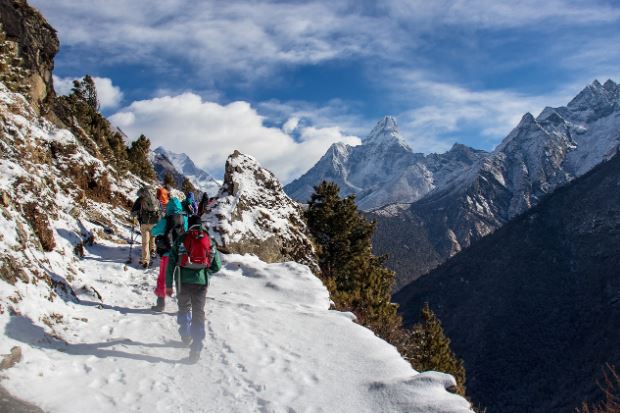Nepal is known for its rich cultural heritage, stunning landscapes, and warm hospitality. Here are five qualities that contribute to the unique appeal of Nepal:
1. Breathtaking Himalayan Landscapes
Nepal is home to eight of the world’s 14 highest peaks, including Mount Everest, the highest point on Earth. The Himalayan Mountain range provides awe-inspiring landscapes, with snow-capped peaks, deep valleys, and picturesque trails for trekking and mountaineering. Nepal offers some of the best trekking trails in the world. The Annapurna Circuit, Langtang Valley, and Everest Base Camp trek are just a few examples of routes that take trekkers through stunning landscapes, allowing them to witness the grandeur of the Himalayas up close. Trekking routes often lead to high mountain passes, providing panoramic views of the surrounding peaks and valleys.

The Himalayan landscapes in Nepal offer an unparalleled natural spectacle, attracting adventurers, trekkers, and nature lovers from around the world. The combination of towering peaks, diverse ecosystems, and cultural integration with nature makes the region truly mesmerizing.
2. Cultural Richness and Diversity
The cultural diversity in Nepal is remarkable, with a tapestry of ethnicities, languages, and traditions. The country celebrates a wide array of festivals, each with its unique rituals, music, dance, and art. The ancient cities of Kathmandu, Bhaktapur, and Patan are hubs of cultural heritage, showcasing historical architecture and artistic craftsmanship. Folk music and dance play a crucial role in Nepali culture. Different ethnic groups have their own traditional music and dance forms, often accompanied by unique instruments.

The cultural richness and diversity of Nepal make it a captivating destination, offering visitors a chance to experience a tapestry of traditions, beliefs, and artistic expressions. The coexistence of various ethnic communities contributes to the country’s unique and harmonious cultural landscape.
3. Spiritual Heritage
Nepal is a melting pot of Hinduism and Buddhism, with numerous temples, stupas, and monasteries scattered throughout the country. Pilgrimage sites like Pashupatinath, Lumbini (the birthplace of Buddha), Manakamana Temple and Boudhanath Stupa hold great religious significance and contribute to Nepal’s spiritual allure. Pashupatinath Temple in Kathmandu is one of the holiest Hindu temples dedicated to Lord Shiva. It is a major pilgrimage site and hosts important religious ceremonies, especially during the Maha Shivaratri festival.

The spiritual heritage of Nepal is deeply ingrained in its landscape, architecture, and daily rituals. The coexistence of Hinduism and Buddhism, along with the numerous sacred sites, makes Nepal a unique destination for those seeking spiritual exploration and cultural immersion.
4. Warm Hospitality and Friendliness
Nepalese people are renowned for their warm hospitality and friendliness. Visitors often experience a genuine and welcoming atmosphere, with locals embracing cultural values that prioritize respect and kindness toward guests. It is common for locals to greet guests with a “Namaste,” a traditional gesture where the palms are pressed together in front of the chest. This gesture signifies respect and goodwill. Nepali people are known for their friendly and approachable nature. Locals are often eager to engage in conversation, share their culture, and assist visitors. Nepali culture places a high value on hospitality and respect for guests.

The warm hospitality and friendliness of the Nepali people contribute significantly to the overall appeal of the country as a tourist destination. It creates an atmosphere of genuine connection and makes visitors feel welcome, fostering positive memories of their time in Nepal.
5. Adventure Tourism Opportunities
Nepal is a premier destination for adventure enthusiasts, offering world-class trekking, mountaineering, and outdoor activities. The Annapurna Circuit, Langtang Valley, Everest Base Camp trek, and various other trails attract adventure seekers from around the world. The diverse landscapes provide opportunities for activities like paragliding, rafting, and wildlife safaris. The scenic town of Pokhara is a hub for paragliding, allowing adventurers to soar above the stunning landscapes of the Annapurna Range and Phewa Lake. Located near the Tibetan border, The Last Resort offers one of the world’s highest bungee jumps, with a 160-meter free fall into the Bhote Koshi River gorge. Experience one of the world’s longest and fastest zip lines, flying over the beautiful landscapes of Pokhara with breathtaking views of the Annapurna Range.

These adventure tourism opportunities, coupled with Nepal’s stunning landscapes and warm hospitality, make the country a haven for thrill-seekers and nature lovers alike. Whether trekking in the Himalayas, conquering mountain peaks, or engaging in water sports, Nepal offers a diverse array of experiences for adventure enthusiasts.
These qualities collectively make Nepal a unique destination that appeals to a broad range of travelers, from those seeking spiritual and cultural experiences to adventurers eager to explore the Himalayan wonders.

